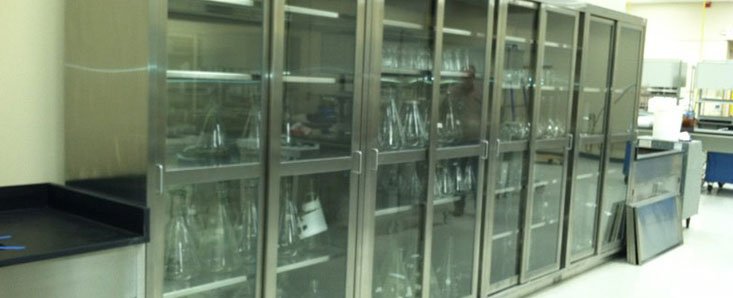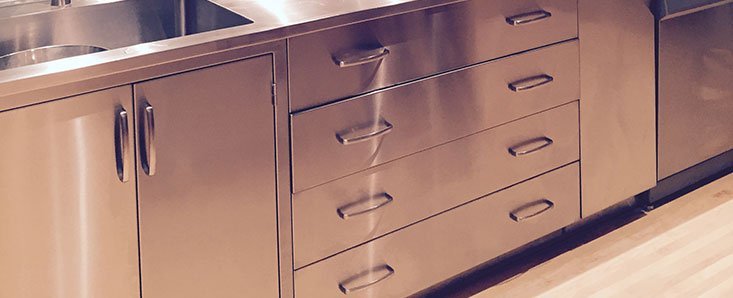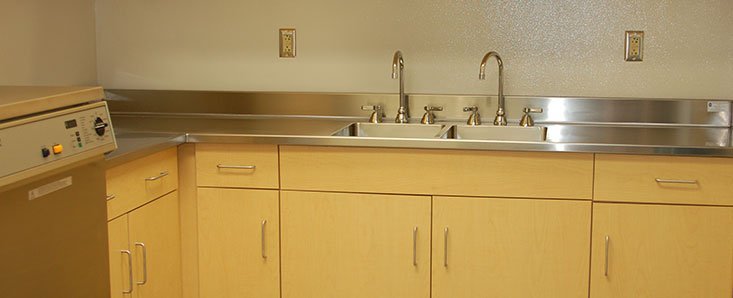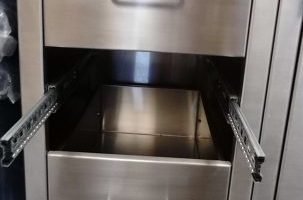Two Most Common Types of Stainless Steel Used in Fabrication
06.13.2023
 |
||
There is no visual difference between Type 304 and Type 316 Stainless Steel. Both are polished and grained the exact same way. In fact, to tell the difference between the two grades often requires a material test report (MTR) of the material to differentiate. Both Type 304 and Type 316 contain Chromium & Nickel, but Type 316 also contains molybdenum.The two most common grades of stainless steel used in fabrication are Type 304 & Type 316 Stainless Steel. What are the differences you may ask? Read on to learn more.
Type 304 Stainless Steel –
Type 304 Stainless Steel contains 18% chromium and 8% nickel. Type 304, with it’s chromium-nickel content is the most widely used and versatile type of stainless steel. It is extremely resistant to corrosion and oxidation and it is durable.
Because of its versatility and durability, Type 304 Stainless Steel can be found in many different environments. Here are a few:
- Commercial Kitchens – There is a reason that commercial kitchens rely on stainless steel. Again, it is corrosion resistant, but Type 304 Stainless Steel is also non-porous. A great factor when preparing food and avoiding cross-contamination. Utensils are also made of stainless steel, for its durability and strength.
- Hospitals – Type 304 Stainless Steel holds up to the heavy use it is subject to in a hospital setting. Stainless steel cabinetry, operating tables, trays and furniture withstand the constant sterilization and cleaning that comes with hospital settings.
- Laboratories – Same as with hospitals, laboratories are great environments for using stainless steel. Type 304 Stainless Steel may be found in cabinetry, counter tops, drip troughs and tools that do not require harsh chemical sterilization.
- Residential – Like with commercial kitchens, residential kitchens are great for stainless steel. Stainless Steel is a recent trend in residential kitchens, with the emergence of stainless steel appliances, but stainless steel has been long used in making cooking utensils, cookware, small appliances and counter tops.
- Industrial – Stainless steel is extremely durable so it’s no surprise to find stainless steel in enclosures, storage tanks, pressure vessels and tubing/piping.
Type 316 Stainless Steel –
Type 316 Stainless Steel is also made up of chromium-nickel. With Type 316 the make up is a bit different. Type 316 stainless steel contains 16% chromium and 10% nickel, but it also contains 2% molybdenum. It is the addition of the molybdenum that makes Type 316 Stainless Steel more resistant to chemical corrosion. You are most likely to find Type 316 Stainless Steel in laboratories and hospitals where there are chemical processes involving sulfuric acid, chlorides, bromides, iodides and fatty acids at high temperatures. In these instances, Type 316 is the right choice.
What are the environments in which it is best to choose Type 316 Stainless Steel?
- Surgical instruments due to chemicals used in cleaning/sterilization.
- Any environment where chemicals such as sulfuric acid, chlorides or bromides are used, such as chemical processing plants.
- High saline environments – Type 316 is the right choice in projects along a coastline and outdoor environments (i.e. outdoor kitchens in coastal regions).
Whether it’s Type 304 or Type 316, Stainless Fabricators, Inc. can take any project and make it to your specifications. From design to completion, SFI can make your ideas reality.













